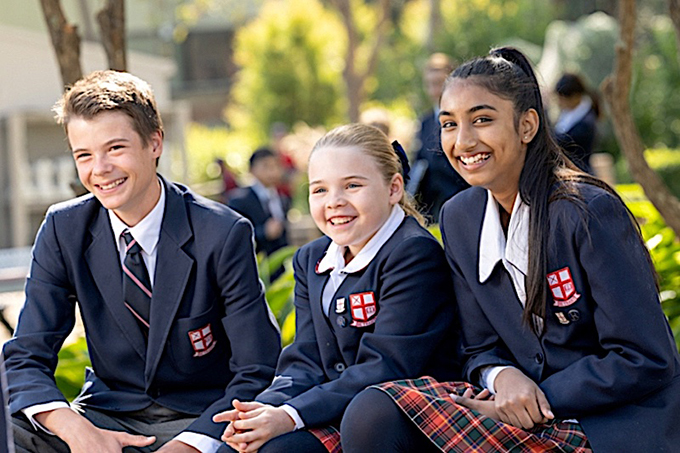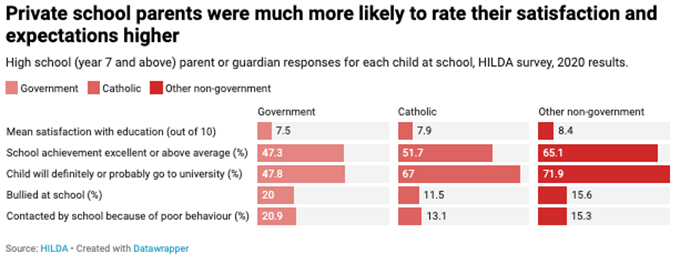
An increasing number of Australian children are going to private high schools, new research shows.
The latest Household, Income and Labour Dynamics in Australia (HILDA) Annual Statistical Report has found an increasing number of students going to public schools over non-government (Catholic and other private) schools for the primary years.
But once students get to high school, the trend is significantly reversed.
Primary school enrolments
The HILDA survey tells the story of the same group of Australians over the course of their lives. Starting in 2001, the survey now tracks more than 17,500 people in 9,500 households. In years 2012, 2016 and 2020, it collected information regarding each child in the household attending school.
The just-released data from 2020 of the HILDA survey found the majority of Australian school kids go to a public primary school and that proportion is growing. Almost 67% of primary school children were enrolled in government schools in 2012. This grew to almost 73% by 2020.
At the same time, there was a dip in primary school enrolments for Catholic and other private schools. Catholic enrolments went from 19.4% to 15.1%, while other private enrolments dropped from nearly 12.7% to 10.9%.
However, by high school, a different trend can be seen.
Private school enrolments
In 2012, 63.4% of high school children were enrolled in government schools. This dropped to 57.2% by 2020.
Catholic enrolments in high school also dipped from 20.9% to 17.8%. But other private schools saw a significant increase: from 13.5% in 2012 to 22.9% in 2020. This is a jump of almost 70%.
The fees for non-government schools are significant, and on the whole are increasing. In 2012, the average fee for a Catholic primary school was A$2,024 per year. For other private schools it was $6,621.
In high school it was $5,477 for Catholic students and $12,407 for other private schools.
By, 2020, fees had increased by 28.5% for Catholic primary school students and 24.5% for Catholic high school students. For other private school students, fees had actually dropped by 4.5% in primary schools, while high school fees had increased slightly by 5.3%.

Private schooling and academic success
While there are many options for schools in Australia, where you live and your financial resources will affect what is available to you.
So, why do so many families pay for private schools, particularly for high school?
High marks and successful university entrance results are obvious reasons. However, research in Australia and worldwide shows the exam scores of children who attended private schools are no different to those in public schools, after accounting for socio-economic background.
That is, the academic achievement of expensive private schools might say more about the families (and their incomes and education levels) who send their children to those schools, rather than anything particularly unique to the school’s teaching and learning.
So, what are the reasons for this increase?
While our 2020 study did not specifically ask parents about their school choices, we did ask them about the levels of satisfaction with their children’s school experience and other various education outcomes.
We found parents of students who attended private schools (both at primary and high-school levels) self-rated the quality of education higher than Catholic or public school parents. For high school parents this was 8.4 in 2020, compared to 7.9 (Catholic) and 7.5 (government).

They were also more likely to declare their their children’s overall achievement as “excellent” or “above average” (65.1%, compared to 51.7% in Catholic schools and 47.3% in government schools).
Meanwhile, 71.9% of private school parents expected their children to go to university, compared to 67% of Catholic school parents and 47.8% of government school parents.
This suggests parents are sending their children to private schools because they think it will give them a better education.
Bullying and behaviour
There is also a chance that they believe their child will face less social and behavioural issues at private schools. Parents of public school students were more likely to say their child had been bullied at both primary and high school.
In primary school, 23.4% of public school parents said their child had been bullied, compared to 19.2% for Catholic parents and 15.4% for other private school parents.
In high school, 20% of public school parents reported bullying compared to 11.5% for the Catholic system and 15.6% for other private schools.
Moreover, in high school, 20.9% of public school parents said they had been contacted by the school for “poor behaviour”, compared to 13.1% for Catholic school parents and 15.3% for other private school parents.
Different attitudes for different stages of school?
Results from the HILDA survey seem to indicate parents may have different motivations around school choice for the primary and secondary years.
For primary school, parents may want to send the children to a local (free) public school because they are understandably not as focused on exam results and career prospects.
But for high school, they may think the extra financial investment is worth it and want a certain type of culture or value system for their teenagers to grow up and study in. Their ideas about academic excellence, citizenship and friendship networks may become more important to try and ensure their children’s desired success in life.
But given access to free, good-quality education is a fundamental right in Australia, these figures are a concern. Parents should not have to pay to get (what they believe is) a better education. And any family, regardless of their income or where they live, should be able to access quality education for their children.
Author Bio: Esperanza Vera-Toscano is a Senior Research Fellow at The University of Melbourne
